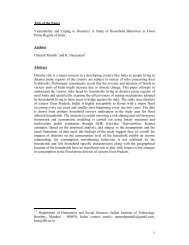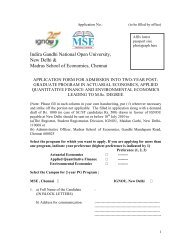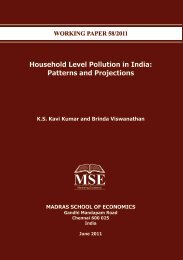Science and Economics for Sustainable Development of India
Science and Economics for Sustainable Development of India
Science and Economics for Sustainable Development of India
Create successful ePaper yourself
Turn your PDF publications into a flip-book with our unique Google optimized e-Paper software.
WORKING PAPER 76/2012<strong>Science</strong> <strong>and</strong> <strong>Economics</strong> <strong>for</strong> <strong>Sustainable</strong><strong>Development</strong> <strong>of</strong> <strong>India</strong>U. SankarMADRAS SCHOOL OF ECONOMICSG<strong>and</strong>hi M<strong>and</strong>apam RoadChennai 600 025<strong>India</strong>December2012
<strong>Science</strong> <strong>and</strong> <strong>Economics</strong> <strong>for</strong> <strong>Sustainable</strong><strong>Development</strong> <strong>of</strong> <strong>India</strong>U. SankarHonorary Pr<strong>of</strong>essor, Madras School <strong>of</strong> <strong>Economics</strong>usankar@mse.ac.ini
WORKING PAPER 76/2012December 2012Price : Rs. 35MADRAS SCHOOL OF ECONOMICSG<strong>and</strong>hi M<strong>and</strong>apam RoadChennai 600 025<strong>India</strong>Phone: 2230 0304/2230 0307/2235 2157Fax : 2235 4847/2235 2155Email : info@mse.ac.inWebsite: www.mse.ac.inii
<strong>Science</strong> <strong>and</strong> <strong>Economics</strong> <strong>for</strong> <strong>Sustainable</strong> <strong>Development</strong> <strong>of</strong><strong>India</strong>U.SANKARAbstractThis paper deals with the interface between science <strong>and</strong> economics inenvironmental policy making in <strong>India</strong>. It explains Nehru‘s concept <strong>of</strong>scientific temper <strong>and</strong> its influence in the <strong>for</strong>mulation <strong>of</strong> science <strong>and</strong>technology policy <strong>and</strong> development <strong>of</strong> the science <strong>and</strong> technologysystem. It reviews the evolution <strong>of</strong> global environmental policy regime<strong>and</strong> the important role assigned to science to gain insights into ecologicalprocesses, to assess the nature <strong>and</strong> causes <strong>of</strong> environmental pollution<strong>and</strong> degradation, <strong>and</strong> to use scientific evidence as basis <strong>for</strong> <strong>for</strong>mulation<strong>of</strong> environmental policies. Then it assesses the roles assigned to science<strong>and</strong> economics in <strong>for</strong>mulation <strong>of</strong> policies relating to pollution prevention<strong>and</strong> control <strong>and</strong> management <strong>of</strong> natural resources in <strong>India</strong>. Theimplications <strong>of</strong> uncertainties <strong>and</strong> risks in environmental management arehighlighted <strong>for</strong> public policy.Keywords: Environmental uncertainties <strong>and</strong> risks, natural resourcesmanagement, pollution prevention <strong>and</strong> control, scientifictemper, sustainable development,JEL Codes: Q2, Q5,O13 <strong>and</strong> P28iii
ACKNOWLEDGMENTAn earlier version <strong>of</strong> this paper was presented as the ―Inaugural Address‖at Madras School <strong>of</strong> <strong>Economics</strong> – Lancaster University ManagementSchool conference: The <strong>Science</strong> <strong>and</strong> <strong>Economics</strong> <strong>of</strong> the EnvironmentIssues: The Twain Shall Meet (19th <strong>and</strong> 20th November, 2012). Theauthor gratefully acknowledges the valuable comments given by theparticipants <strong>of</strong> the conference.iv
INTRODUCTIONIn the fifties <strong>and</strong> the sixties the primary objectives <strong>of</strong> science <strong>and</strong>technology policy in <strong>India</strong> were economic growth <strong>and</strong> self-reliance. Fromthe seventies, social <strong>and</strong> environmental considerations <strong>and</strong> leadership ina few strategic sectors influenced allocation <strong>of</strong> resources <strong>for</strong> science <strong>and</strong>technology sectors. The importance <strong>of</strong> scientific evidence <strong>and</strong> the role <strong>of</strong>economics in framing optimal policies <strong>for</strong> achieving sustainabledevelopment gained momentum since the United Nations Conference onEnvironment <strong>and</strong> <strong>Development</strong> in 1992.This paper aims to highlight the significant roles <strong>of</strong> science <strong>and</strong>economics <strong>for</strong> sustainable development <strong>of</strong> <strong>India</strong>. This paper proceed asfollows. The next section deals with the concept <strong>of</strong> scientific temper <strong>and</strong>its influence in the <strong>for</strong>mulation <strong>of</strong> science <strong>and</strong> technology policy <strong>and</strong>development <strong>of</strong> the science <strong>and</strong> technology system. The following sectiondeals with the evolution <strong>of</strong> global environmental policy regime <strong>and</strong> theimportant role assigned to science to gain insights into ecologicalprocesses, to assess the nature <strong>and</strong> causes <strong>of</strong> environmental pollution<strong>and</strong> degradation, <strong>and</strong> to use scientific evidence as basis <strong>for</strong> <strong>for</strong>mulation<strong>of</strong> environmental policies. It states how economics with scientific basiscan contribute to <strong>for</strong>mulation <strong>of</strong> sustainable development policies. Then<strong>India</strong>‘s environmental policy regime is dealt with. It assesses the rolesassigned to science <strong>and</strong> economics in <strong>for</strong>mulation <strong>of</strong> policies relating topollution prevention <strong>and</strong> control <strong>and</strong> in management <strong>of</strong> naturalresources. Then we, note some uncertainties <strong>and</strong> risks in environmentalmanagement <strong>and</strong> their implications <strong>for</strong> science policy <strong>and</strong> economicpolicy. The final section provides the concluding remarks.1
SCIENTIFIC TEMPER AND SCIENCE AND TECHNOLOGYPOLICY IN INDIAJawaharlal Nehru, the first Prime Minister <strong>of</strong> <strong>India</strong>, crusaded <strong>for</strong> scientifictemper. The 42nd Amendment Part IV-A Article 51-A (h) in 1976 onFundamental Duties reads: (It shall be the duty <strong>of</strong> every citizen <strong>of</strong> <strong>India</strong>)to develop the scientific temper, humanism <strong>and</strong> the spirit <strong>of</strong> inquiry <strong>and</strong>re<strong>for</strong>m. Sen (2006), <strong>Economics</strong> Nobel Laureate, says scientific temperinvolves the application <strong>of</strong> logic <strong>and</strong> reasoning, <strong>and</strong> the avoidance <strong>of</strong> bias<strong>and</strong> preconceived notions in arriving at decisions, <strong>and</strong> becomesparticularly valuable while deciding what is best <strong>for</strong> the community or thenation. According to him a group that practices the scientific temper hastwo characteristics – internal pluralism <strong>and</strong> external receptivity. Ramesh(2011), <strong>for</strong>mer Minister <strong>of</strong> Environment <strong>and</strong> Forests, says that ‗theessence <strong>of</strong> Nehru‘s fixation on scientific temper was this—a questioningmind, pushing the limits, not getting encumbered or structured by narrowlimited concerns, not afraid to be inconsistent with changing facts <strong>and</strong>circumstances but always proceeding on the basis <strong>of</strong> objective realities,not prisoner <strong>of</strong> any dogma, modern or archaic‘. Thus, openness,neutrality, receptivity to changing facts <strong>and</strong> objectivity characterize thescientific temper.The Scientific Policy Resolution <strong>of</strong> 1958 <strong>and</strong> the TechnologyPolicy Statement <strong>of</strong> 1983 emphasize self-reliance, as also sustainable <strong>and</strong>equitable development. <strong>Science</strong> <strong>and</strong> Technology Policy <strong>of</strong> 2003 notes that‗science <strong>and</strong> technology have had unprecedented impact on economicgrowth <strong>and</strong> social development. Knowledge has become a source <strong>of</strong>economic might <strong>and</strong> power. This has led to increased restrictions onsharing <strong>of</strong> knowledge, to new norms <strong>of</strong> intellectual property rights, <strong>and</strong>to global trade <strong>and</strong> technology control regimes. Scientific <strong>and</strong>technological developments today also have deep ethical, legal <strong>and</strong> socialimplications‘ (Government <strong>of</strong> <strong>India</strong>, 2003). Narasimha (2008) examines2
how science <strong>and</strong> technology in <strong>India</strong> have influenced <strong>and</strong> in turn beeninfluenced by economic policy <strong>and</strong> strategic considerations.The <strong>Science</strong> <strong>and</strong> Technology system in <strong>India</strong> consists <strong>of</strong> centralgovernment science <strong>and</strong> technology departments (Department <strong>of</strong> AtomicEnergy, Department <strong>of</strong> Space, Department <strong>of</strong> <strong>Science</strong> <strong>and</strong> Technology,Department <strong>of</strong> Biotechnology, Department <strong>of</strong> Scientific <strong>and</strong> IndustrialResearch including Council <strong>of</strong> Scientific <strong>and</strong> Industrial Researchinstitutions, Ministry <strong>of</strong> Earth <strong>Science</strong>s, science research institutionsfunded by different ministries), state governments‘ science <strong>and</strong>technology departments, in-house R&D in private industry, sciencedepartments in <strong>India</strong>n Institute <strong>of</strong> Technology, universities, <strong>and</strong> in non –government organizations.Solow‘s (1957) pioneering work on the measurement <strong>of</strong>contribution <strong>of</strong> technical change to economic growth stimulated extensiveresearch on the nature <strong>and</strong> sources <strong>of</strong> total factor productivity growth.Now we know that the contribution <strong>of</strong> technical progress to economicgrowth comes in the following <strong>for</strong>ms: (a) upward shifts in productionfunctions lowering input-output ratios, (b) technical progress embodied ininputs, (c) discovery <strong>of</strong> new materials, new resources, processes <strong>and</strong>products <strong>and</strong> improvements in organizational efficiency, <strong>and</strong> (d)substitution <strong>of</strong> limitational inputs by new materials.In recent years, the intellectual property regime <strong>and</strong>consequential access issue to the technologies, restrictions on technologytransfers, risks associated with certain technologies like geneticallymodified organisms, transparency <strong>and</strong> neutrality <strong>of</strong> scientific facts <strong>and</strong>above all ethical, social <strong>and</strong> environmental dimensions <strong>of</strong> newtechnologies, processes <strong>and</strong> products raise many public policy issues. Anew <strong>Science</strong> <strong>and</strong> Technology policy is expected to be unveiled by end <strong>of</strong>2012.3
EVOLUTION OF GLOBAL ENVIRONMENT POLICYThe United Nations Conference on the Human Environment at Stockholmfrom 5 to 16 June 1972 proclaims that ‗Man has constantly to sum upexperience <strong>and</strong> go on discovering, inventing, creating <strong>and</strong> advancing. Inour time, man's capability to trans<strong>for</strong>m his surroundings, if used wisely,can bring to all peoples the benefits <strong>of</strong> development <strong>and</strong> the opportunityto enhance the quality <strong>of</strong> life. Wrongly or heedlessly applied, the samepower can do incalculable harm to human beings <strong>and</strong> the humanenvironment. We see around us growing evidence <strong>of</strong> man-made harm inmany regions <strong>of</strong> the earth: dangerous levels <strong>of</strong> pollution in water, air,earth <strong>and</strong> living beings; major <strong>and</strong> undesirable disturbances to theecological balance <strong>of</strong> the biosphere; destruction <strong>and</strong> depletion <strong>of</strong>irreplaceable resources; <strong>and</strong> gross deficiencies, harmful to the physical,mental <strong>and</strong> social health <strong>of</strong> man, in the man-made environment,particularly in the living <strong>and</strong> working environment‘, (United NationsConference on Human Environment, 1972).The UN Conference on Environment <strong>and</strong> <strong>Development</strong> came withRio Declaration, a set <strong>of</strong> principles <strong>for</strong> environment <strong>and</strong> developmentpolicy, <strong>and</strong> Agenda 21, an action plan <strong>for</strong> the future. Three importantprinciples in the Rio Declaration relating to science <strong>and</strong> economics are:Principle 18<strong>Science</strong> <strong>and</strong> technology, as part <strong>of</strong> their contribution to economic <strong>and</strong>social development, must be applied to the identification, avoidance <strong>and</strong>control <strong>of</strong> environmental risks <strong>and</strong> the solution <strong>of</strong> environmentalproblems <strong>and</strong> <strong>for</strong> the common good <strong>of</strong> mankind.Principle16National authorities should endeavour to promote the internalization <strong>of</strong>environmental costs <strong>and</strong> the use <strong>of</strong> economic instruments, taking intoaccount the approach that the polluter should, in principle, bear the cost4
<strong>of</strong> pollution, with due regard to the public interest <strong>and</strong> without distortinginternational trade <strong>and</strong> investment.Principle 15In order to protect the environment, the precautionary approach shall bewidely applied by States according to their capabilities. Where there arethreats <strong>of</strong> serious or irreversible damage, lack <strong>of</strong> full scientific certaintyshall not be used as a reason <strong>for</strong> postponing cost-effective measures toprevent environmental degradation (United Nations Conference onEnvironment <strong>and</strong> <strong>Development</strong>, 1992).Agenda 21, Chapter 35 is on the role <strong>and</strong> the use <strong>of</strong> the sciencesin supporting the prudent management <strong>of</strong> the environment <strong>and</strong>development <strong>for</strong> the daily survival <strong>and</strong> future development <strong>of</strong> humanity.It notes that a ‗first step towards improving the scientific basis <strong>for</strong> thesestrategies is a better underst<strong>and</strong>ing <strong>of</strong> l<strong>and</strong>, oceans, atmosphere <strong>and</strong>their interlocking water, nutrient <strong>and</strong> biogeochemical cycles <strong>and</strong> energyflows which all <strong>for</strong>m part <strong>of</strong> the Earth system. This is essential if a moreaccurate estimate is to be provided <strong>of</strong> the carrying capacity <strong>of</strong> the planetEarth <strong>and</strong> <strong>of</strong> its resilience under the many stresses placed upon it byhuman activities. The sciences can provide this underst<strong>and</strong>ing throughincreased research into the underlying ecological processes <strong>and</strong> throughthe application <strong>of</strong> modern, effective <strong>and</strong> efficient tools that are nowavailable, such as remote-sensing devices, robotic monitoringinstruments <strong>and</strong> computing <strong>and</strong> modelling capabilities‘ (p. 401).Two important outcomes <strong>of</strong> the Rio Conference are the UnitedNations Framework Convention on Climate Change <strong>and</strong> the Conventionon Biodiversity.The World Summit on <strong>Sustainable</strong> <strong>Development</strong> 2002 inJohannesburg came with the Johannesburg Plan <strong>of</strong> Implementation. Itcalls <strong>for</strong> ‗the integration <strong>of</strong> the three components <strong>of</strong> sustainable5
development -economic development, social development <strong>and</strong>environmental protection - as interdependent <strong>and</strong> mutually rein<strong>for</strong>cingpillars. Poverty eradication, changing unsustainable patterns <strong>of</strong>production <strong>and</strong> consumption <strong>and</strong> protecting <strong>and</strong> managing the naturalresource base <strong>of</strong> economic <strong>and</strong> social development are overarchingobjectives <strong>of</strong>, <strong>and</strong> essential requirements <strong>for</strong>, sustainable development‘,(The World Summit on <strong>Sustainable</strong> <strong>Development</strong>, 2002).The UN Conference on <strong>Sustainable</strong> <strong>Development</strong> (2012) has amajor theme: Green Economy in the context <strong>of</strong> <strong>Sustainable</strong> <strong>Development</strong><strong>and</strong> Poverty Eradication. Para 69(g) <strong>of</strong> the final report urges the need topromote ‗ the science-policy interface through inclusive, evidence-based<strong>and</strong> transparent scientific assessments, as well as access to reliable,relevant <strong>and</strong> timely data in areas related to the three dimensions <strong>of</strong>sustainable development‘ (United Nations Conference on Environment<strong>and</strong> <strong>Development</strong>, 2012). It also urges enhanced participation <strong>and</strong>effective engagement <strong>of</strong> civil society. Para 63 recognizes the importance<strong>of</strong> the evaluation <strong>of</strong> the range <strong>of</strong> social, environmental <strong>and</strong> economicfactors <strong>and</strong> encourage, where national circumstances <strong>and</strong> conditionsallow, their integration into decision-making. Para 76 (a) resolves tostrengthen the institutional framework <strong>for</strong> sustainable development,which will, inter alia, promote the balanced integration <strong>of</strong> the threedimensions <strong>of</strong> sustainable development. Thus, the Rio + 20 envisages aninter-face between science <strong>and</strong> economics in balancing <strong>and</strong> integratingthe three pillars – economic, social <strong>and</strong> environmental- <strong>of</strong> sustainabledevelopment based on scientific evidence <strong>and</strong> active public participation.Thus, even though the UN summits assign a prominent role toscience-based environmental policy, they recognize the important role <strong>of</strong>economic analysis in internalizing environmental costs in producers <strong>and</strong>consumers decisions, designing economic instruments <strong>for</strong> pollutioncontrol, economic valuation <strong>of</strong> natural resources <strong>and</strong> evaluation <strong>of</strong> trade–<strong>of</strong>fs among the three pillars <strong>of</strong> sustainable development.6
INDIA’S ENVIRONMENTAL POLICY REGIMEThe UN Conference on Human Environment in 1972 exerted a majorinfluence on environmental policy in <strong>India</strong>. The government set up aNational Committee on Environmental Planning <strong>and</strong> Coordination in 1972.The 42 nd Constitution Amendment Act 1976, Article 48A (DirectivePrinciples) states that ‗the state shall endeavour to protect <strong>and</strong> improvethe environment <strong>and</strong> to safeguard the <strong>for</strong>ests <strong>and</strong> wildlife <strong>of</strong> the country‘.Article 51 A (g) (Fundamental Duties) aims ‗to protect <strong>and</strong> improve thenatural environment including <strong>for</strong>ests, lakes, rivers, wild life <strong>and</strong> to havecompassion <strong>for</strong> living creatures‘. The UN Conference on Environment <strong>and</strong><strong>Development</strong> in 1992 <strong>and</strong> its Agenda 21 influenced pollution prevention<strong>and</strong> control <strong>and</strong> natural resource management policies.(a) Pollution Prevention <strong>and</strong> ControlEnvironmental legislations such as the Water (Prevention <strong>and</strong> Control <strong>of</strong>Pollution) Act 1974, the Air (Prevention <strong>and</strong> Control <strong>of</strong> Pollution) Act1981, the Environment (Protection) Act 1986, the Public LiabilityInsurance Act 1991 <strong>and</strong> the National Environmental Tribunal Act 1995were enacted. All environmental laws come under criminal laws. TheWater Act paved the way <strong>for</strong> the establishment <strong>of</strong> Central <strong>and</strong> StatePollution Control Boards.The Central Pollution Control Board adopts the st<strong>and</strong>ards <strong>and</strong>control regime. It prescribes minimum national st<strong>and</strong>ards based oncomprehensive industry studies undertaken by technical institutions.There are three types <strong>of</strong> st<strong>and</strong>ards: concentration-based, equipment –based, <strong>and</strong> load-based. The State Governments <strong>and</strong> the State PollutionControl Boards can prescribe tighter st<strong>and</strong>ards taking into considerationthe assimilative capacity <strong>of</strong> the local environments. In the comm<strong>and</strong> <strong>and</strong>control regime, compliance is generally poor.7
under the prevailing pollution control regime <strong>and</strong> as the administrativecapacity exists <strong>for</strong> levying <strong>and</strong> collecting the taxes with the tax authoritiesin <strong>India</strong>, the Ministry <strong>of</strong> Environment <strong>and</strong> Forests asked Madras School <strong>of</strong><strong>Economics</strong> to recommend eco taxes <strong>for</strong> consideration by the government.Chelliah, et. al., (2007) recommended coal cess based on its ash <strong>and</strong>moisture content, tax concessions <strong>for</strong> environment friendly substitutes <strong>for</strong>chlorine, phosphates, chemical fertilizers <strong>and</strong> pesticides, <strong>and</strong> policies <strong>for</strong>pollution reduction in automobiles, plastics <strong>and</strong> lead acid batteriesdisposal. In the 2010-11 Union Budget, a cess on coal at the rate <strong>of</strong> Rs50 per tone was introduced. Tax differentiation, tax exemptions,concessional taxes, <strong>and</strong> lower taxes <strong>for</strong> certain environment-friendlygoods were announced in the 2011-12 Union Budget.At present, the government relies largely on tax concessions <strong>and</strong>subsidies e.g., rebates on customs <strong>and</strong> excise duties, accelerateddepreciation allowances, <strong>and</strong> capital <strong>and</strong> interest subsidies <strong>for</strong> pollutionabatement <strong>and</strong> use <strong>of</strong> environment-friendly/ climate-friendly substitutes.Other economic instruments like bank guarantees <strong>for</strong> compliance withpollution control legislations, deposit refund systems, green rating, <strong>and</strong>preference <strong>for</strong> environment-friendly products in public procurement arebeing encouraged.Tradable pollution permits provide incentives <strong>for</strong> the pollutingunits to internalize environmental costs in their decision making. Theysatisfy environmental effectiveness criterion as well as dynamicefficiency. Their introduction requires political acceptance <strong>of</strong> the idea,creation <strong>of</strong> large market <strong>for</strong> trading <strong>and</strong> administrative capacity <strong>for</strong>measurement <strong>and</strong> monitoring <strong>of</strong> pollution. Government <strong>of</strong> <strong>India</strong> (2010b),in the Discussion Paper on Emission trading, says <strong>India</strong> needs robust <strong>and</strong>innovative regulations that leverage technology <strong>and</strong> harness markets toensure compliance in a cost-effective manner. Another reason <strong>for</strong>introducing pollution control based on aggregate emissions is that, in thepresent regulation concentrated on en<strong>for</strong>cing source-specific st<strong>and</strong>ards,9
there is no link between ambient <strong>and</strong> source st<strong>and</strong>ards in terms <strong>of</strong> thevolume <strong>of</strong> polluting activities. If the permits are auctioned, there is a newsource <strong>of</strong> revenue to the government. For successful implementation fourimportant areas are: setting the cap, allocating permits (gr<strong>and</strong> fatheringor auctioning), monitoring <strong>and</strong> compliance. The ‗Per<strong>for</strong>m, Achieve <strong>and</strong>Trade‘ initiative <strong>of</strong> Bureau <strong>of</strong> Energy Efficiency <strong>for</strong> achieving energysavings in large industrial units is a market-based instrument.Environmental policy re<strong>for</strong>m based on sound science <strong>and</strong> publicparticipation can internalize environmental costs in decision making <strong>and</strong>influence peoples‘ behavior to improve environmental quality.Introduction <strong>of</strong> pollution charges, taxes <strong>and</strong> cesses, creation <strong>of</strong> markets<strong>for</strong> emission trading, <strong>and</strong> penalties <strong>for</strong> non-compliance at rates higherthan the compliance costs will also generate new financial resources <strong>for</strong>environmental management As <strong>India</strong> is becoming a globalised marketeconomy, <strong>and</strong> it is a member <strong>of</strong> World Trade Organization <strong>and</strong> manymultilateral environmental agreements <strong>India</strong> can achieve sustainabledevelopment goals by using market-based instruments.There is a need <strong>for</strong> promotion <strong>of</strong> environmentally soundtechnologies. Agenda 21, Chapter 34, says ‗environmentally soundtechnologies protect the environment, are less polluting, use (all)resources at a more sustainable manner, recycle more <strong>of</strong> their wastes<strong>and</strong> products, <strong>and</strong> h<strong>and</strong>le residual wastes in a more acceptable mannerthan the technologies <strong>for</strong> which they were substitutes‘. It says these are‗not just individual technologies, but total systems which include knowhow,procedures, goods <strong>and</strong> services, <strong>and</strong> equipment as well asorganizational <strong>and</strong> managerial procedures‘.In most developing countries including <strong>India</strong>, micro, small <strong>and</strong>medium enterprises account <strong>for</strong> nearly half <strong>of</strong> the industrial output <strong>and</strong>more than half <strong>of</strong> the share in employment. Environmental managementis difficult in this sector because these units are dispersed <strong>and</strong> there is no10
in<strong>for</strong>mation base on the emissions <strong>and</strong> wastes. In view <strong>of</strong> the socialbenefits like decentralized development <strong>and</strong> employment generationespecially <strong>for</strong> weaker sections, sustainable development <strong>of</strong> these unitsrequire special ef<strong>for</strong>ts <strong>for</strong> transfer <strong>of</strong> environmentally sound technologiesto these units. While industry –specific <strong>and</strong> location-specific scientificresearch is necessary <strong>for</strong> identification <strong>of</strong> the technologies appropriate tothe industries, social cost benefit analysis <strong>of</strong> transfer <strong>of</strong> environmentallysound technologies in terms <strong>of</strong> net economic , social <strong>and</strong> environmentalbenefits would be useful <strong>for</strong> framing policy instruments <strong>for</strong> sustainabledevelopment <strong>of</strong> these industries. See Central Pollution Control Board(2011) <strong>for</strong> status <strong>of</strong> the existing technologies <strong>and</strong> potential <strong>for</strong> adoption<strong>of</strong> clean technologies.Integration <strong>of</strong> the three pillars <strong>of</strong> sustainable development inpublic policies in a balanced measure is a difficult exercise. Itnecessitates the evaluation <strong>of</strong> costs <strong>and</strong> benefits <strong>of</strong> designing <strong>and</strong>implementing alternative policies, based on national circumstances <strong>and</strong>policies, in terms <strong>of</strong> the three pillars. For example, pursuit <strong>of</strong> economicefficiency <strong>and</strong> environmental effectiveness goals requires that all pricesreflect their social (private <strong>and</strong> environmental) costs. But social goalssuch as poverty eradication <strong>and</strong> ensuring access to clean energy to poorat af<strong>for</strong>dable prices necessitate provision <strong>of</strong> food <strong>and</strong> energy ataf<strong>for</strong>dable prices to the poor, which means setting the prices below theirsocial costs <strong>and</strong> government bearing the subsidy burden. Social benefitcost analysis can contribute to evaluation <strong>of</strong> the policy trade- <strong>of</strong>fs ,determining the extent <strong>of</strong> <strong>and</strong> phasing out <strong>of</strong> the subsidies, <strong>and</strong> bettertargeting <strong>of</strong> the subsidies to the poor by using unique identificationcards.(b) Natural Resources ManagementThe Botanical Survey <strong>of</strong> <strong>India</strong> <strong>for</strong> carrying out taxonomic <strong>and</strong> floristicstudies in wild plant reserves was established in 1890. It is responsible<strong>for</strong> exploration, inventorying <strong>and</strong> documentation <strong>of</strong> phytodiversity,11
identification <strong>of</strong> threshold species, survey <strong>and</strong> documentation <strong>of</strong>traditional knowledge <strong>and</strong> development <strong>of</strong> national database <strong>of</strong> <strong>India</strong>nplants. The Zoological Survey <strong>of</strong> <strong>India</strong>, established in 1916, has am<strong>and</strong>ate to survey, collection, documentation <strong>and</strong> ex situ conservation <strong>of</strong>wild animal diversity <strong>of</strong> the country. <strong>India</strong> has institutions <strong>for</strong> <strong>for</strong>estsurvey, conservation <strong>and</strong> management <strong>of</strong> mangroves <strong>and</strong> coral reefs,national river conservation, <strong>and</strong> regeneration <strong>and</strong> eco development. <strong>India</strong>has 4.92 per cent <strong>of</strong> its geographical area under protected areas. Theprotected areas include 102 national parks, 516 wildlife sanctuaries, 49conservation reserves <strong>and</strong> 4 community reserves.<strong>India</strong> has been successful in using satellite technology <strong>for</strong><strong>for</strong>ecasting weather, flood <strong>and</strong> tropical cyclones, disaster management,<strong>and</strong> agro meteorological advisory services. Remote sensing technology isbeing used <strong>for</strong> wastel<strong>and</strong> mapping, biodiversity characterization atl<strong>and</strong>scape level, <strong>for</strong>est cover mapping, <strong>and</strong> coastal zone mapping. For anassessment <strong>of</strong> the costs <strong>and</strong> benefits <strong>of</strong> using geosynchronous <strong>and</strong>remote sensing satellites services in various applications, see Sankar(2007).The Planning Commission-National Natural ResourcesManagement System, constituted in 1983, is an apex body <strong>and</strong> hasmembers from various central government departments which deals withnatural resources <strong>and</strong> environment. For geospatial application <strong>and</strong>decision support system in meteorological <strong>and</strong> oceanographic studies,water in<strong>for</strong>mation system, earth observation system, rainfed agriculturalcrop system, <strong>for</strong>est protection, biodiversity conservation <strong>and</strong> flood hazardmapping, see Government <strong>of</strong> <strong>India</strong> (2012). Interface between thescientists <strong>and</strong> social scientists needs to be strengthened.The dominant theme <strong>of</strong> National Environment Policy 2006 is thatwhile conservation <strong>of</strong> environmental resources is necessary to securelivelihoods <strong>and</strong> well-being <strong>of</strong> all, the most secure basis <strong>for</strong> conservation is12
to ensure that people dependent on particular resources obtain betterlivelihoods from the fact <strong>of</strong> conservation, than from degradation <strong>of</strong> theresources. The 12th Plan Working Group report on Ecosystems,Restoration, Biodiversity on <strong>Sustainable</strong> Livelihoods notes that deficit ingovernance is the most significant challenge be<strong>for</strong>e the society(Government <strong>of</strong> <strong>India</strong>, 2011). The Forest Rights Act is yet to beimplemented fully. Clear definition <strong>of</strong> <strong>for</strong>est rights <strong>and</strong> en<strong>for</strong>cement isnecessary <strong>for</strong> sustainable management <strong>of</strong> <strong>for</strong>est resources. Livelihoodsupport through non- timber <strong>for</strong>est products can be enhanced bystrengthening the supply chain <strong>and</strong> providing minimum support price,wherever feasible. There is also a need to synergize joint <strong>for</strong>estmanagement, rural employment guarantee scheme <strong>and</strong> eco-restorationprogrammes to promote sustainable management <strong>of</strong> natural resources.The access <strong>and</strong> benefit sharing regime <strong>of</strong> the Convention on Biodiversitymust reward suitably the custodians <strong>of</strong> traditional knowledge <strong>and</strong>biological resources.As <strong>for</strong> ecosystem services, markets exist only <strong>for</strong> certainprovisioning services <strong>and</strong> most <strong>of</strong> these markets are imperfect. Mostecosystem services have use values <strong>and</strong> non-use values. Valuation <strong>of</strong>ecosystem services is necessary to incorporate their values in public <strong>and</strong>private decision making. Payments <strong>for</strong> ecosystem services, whereverfeasible, must be attempted. We must realize that most ecosystemservices have become scarce <strong>and</strong> their conservation <strong>and</strong> sustainable useenhance the well being <strong>of</strong> society, particularly the poor. Community -based self- governing organizations may be promoted <strong>for</strong> managingcommon pool resources such as village commons, watersheds, <strong>and</strong>wetl<strong>and</strong>s related to the provisions <strong>of</strong> common property resources.In February 2011, the Ministry <strong>of</strong> Environment <strong>and</strong> Forests hasinitiated a major new programme-The <strong>Economics</strong> <strong>of</strong> Ecosystems <strong>and</strong>Biodiversity (TEEB) study- <strong>of</strong> valuing its natural capital <strong>and</strong> ecosystemservices in terms <strong>of</strong> economic value. The expected outputs <strong>of</strong> TEEB are: a13
survey <strong>of</strong> biodiversity <strong>and</strong> ecosystem services coming from variousbiomes to the socio-economic groups that benefit from them, particularlyin terms <strong>of</strong> livelihoods, health, food, water <strong>and</strong> energy; a framework <strong>of</strong>what <strong>and</strong> how to value natural resources in <strong>India</strong>; mapping ecosystemservices <strong>and</strong> their values; calculating Environmental Adjusted StateDomestic Product from changes in <strong>for</strong>ests, freshwater, agricultural l<strong>and</strong><strong>and</strong> carbon sequestration; calculating Green Domestic Product <strong>and</strong>Green State Domestic Product <strong>and</strong> GDP <strong>of</strong> Rural <strong>and</strong> Forest DependantPoor.SCIENTIFIC UNCERTAINTIES, ENVIRONMENTAL RISKSAND PUBLIC POLICY<strong>Science</strong> can play an important role in identifying potential environmentalhazards <strong>and</strong> highlighting planetary boundaries so that humanity canoperate safely. The strong scientific evidence <strong>for</strong> depletion <strong>of</strong> ozone layerresulted in the Montreal Protocol on Ozone Depleting Substances (ODS)<strong>and</strong> the small number <strong>of</strong> ODS producers <strong>and</strong> availability <strong>of</strong> substitutes <strong>for</strong>ODS facilitated successful implementation <strong>of</strong> the Protocol.In the case <strong>of</strong> climate change, the Intergovernmental Panel onClimate change in its Fourth Assessment Report alerted that ‗warming <strong>of</strong>the climate system is unequivocal, as is evident from observations <strong>of</strong>increases in global average air <strong>and</strong> ocean temperatures, widespreadmelting <strong>of</strong> snow <strong>and</strong> ice <strong>and</strong> rising global average sea level‘(Intergovernmental Panel on Climate Change, 2007). However, theprospects <strong>of</strong> reaching a global agreement on containing green house gasemissions appear to be dim now.There are uncertainties regarding estimates <strong>of</strong> cumulative <strong>and</strong>current greenhouse gas emissions, likelihood <strong>of</strong> the increase in globalwarming <strong>and</strong> the economic <strong>and</strong> social impacts. IPCC Working Groupreports recognize the nature <strong>and</strong> sources <strong>of</strong> uncertainty because they14
consider materials from many disciplines which use diverse approaches;qualitative uncertainty is characterized by providing a relative sense <strong>of</strong>the quality <strong>of</strong> evidence <strong>and</strong> the degree <strong>of</strong> agreement among thereviewers; <strong>and</strong> where uncertainty is assessed using statistical evidence<strong>and</strong> expert judgments, then the reports indicate the likelihood rangese.g., 90 per cent intervals. There are many climate sceptics.From an economic perspective, the following issues arise. First,climate change is an extreme event <strong>and</strong> may be a catastrophe. Hence,the expected utility analysis may be inappropriate; safety –first approachis more appropriate. Second, as studies by Nordhaus, Stern <strong>and</strong> manyothers reveal thatthe policy decision whether to act now or laterdepends crucially on the choice <strong>of</strong> the discount rate in the calculation <strong>of</strong>the net present values. Third, as Weitzman (2009) has shown, theconventional cost benefit analysis breaks down because <strong>of</strong> the cascadingeffects <strong>of</strong> uncertainties- from estimates <strong>of</strong> greenhouse gas emissions tothe ultimate impact on per capita consumption. Fourth, global warming isa global public bad <strong>and</strong> we need international cooperation to reach abinding agreement on emission reductions <strong>and</strong> sharing <strong>of</strong> the mitigation<strong>and</strong> adaptation costs. In view <strong>of</strong> the large uncertainties <strong>and</strong> the need <strong>for</strong>preventing irreversible damages/ catastrophes, precautionary approach isdesirable.<strong>India</strong> came with a National Action Plan on Climate Change in2008.The eight national missions are: National Solar Mission, NationalMission <strong>for</strong> Increased Energy Efficiency, National Mission on <strong>Sustainable</strong>Habitat, National Water mission, National Mission <strong>for</strong> Sustaining theHimalayan Ecosystem, National Mission <strong>for</strong> a Green <strong>India</strong>, NationalMission <strong>for</strong> <strong>Sustainable</strong> Agriculture <strong>and</strong> National Mission <strong>for</strong> StrategicKnowledge <strong>for</strong> Climate Change. The technical document spells out thetechnological options available, co-benefits, R&D collaboration,technology transfer, regulatory options <strong>and</strong> capacity building needs15
(Government <strong>of</strong> <strong>India</strong>, 2008). <strong>India</strong> is able to provide greenhouse gasinventory in<strong>for</strong>mation. It has set up a climate modeling <strong>for</strong>um.Commercialisation <strong>of</strong> Bt brinjal in <strong>India</strong> generated a heateddebate on the reliability <strong>of</strong> scientific in<strong>for</strong>mation, impact on the farmers‘access to the seeds, potential adverse effects on the traditional varieties,<strong>and</strong> also the need. Presenting a detailed note on the debate, JairamRamesh, then Minister <strong>of</strong> Environment <strong>and</strong> Forests, says: when there isno clear consensus within the scientific community itself, when there isso much opposition from the state governments, when responsible civilsociety organisations <strong>and</strong> eminent scientists have raised many seriousquestions that have not been answered satisfactorily, when the publicsentiment is negative <strong>and</strong> when Bt-brinjal will be the very firstgenetically-modified vegetable to be introduced anywhere in the world<strong>and</strong> when there is no over-riding urgency to introduce it here, it is myduty to adopt a cautious, precautionary principle-based approach <strong>and</strong>impose a moratorium on the release <strong>of</strong> Bt-brinjal, till such timeindependent scientific studies establish, to the satisfaction <strong>of</strong> both thepublic <strong>and</strong> pr<strong>of</strong>essionals, the safety <strong>of</strong> the product from the point <strong>of</strong> view<strong>of</strong> its long-term impact on human health <strong>and</strong> environment, including therich genetic wealth existing in brinjal in our country (Government <strong>of</strong><strong>India</strong>, 2010a).Rockström et. al., (2009) report that ‗anthropogenic pressures onthe Earth System have reached a scale where abrupt globalenvironmental change can no longer be excluded‘. They propose a newapproach to global sustainability in which they define planetaryboundaries within which we expect that humanity can operate safely.According to them transgressing one or more planetary boundaries maybe deleterious or even catastrophic due to the risk <strong>of</strong> crossing thresholdsthat will trigger non-linear, abrupt environmental change withincontinental- to planetary-scale systems. The identified nine planetaryboundaries are: (1) climate change, (2) ocean acidification, (3)16
stratospheric ozone, (4) biogeochemical nitrogen (N) cyclephosphorus (P) cycle, (5) global freshwater use,(6) l<strong>and</strong> system change(7) the rate at which biological diversity is losing ,(8) chemical pollution,<strong>and</strong> (9) atmospheric aerosol loading. Drawing upon current scientificunderst<strong>and</strong>ing, they propose quantifications <strong>for</strong> the first seven <strong>of</strong>them. They say that humanity has already transgressed the planetaryboundaries <strong>for</strong> climate change, rate <strong>of</strong> biodiversity loss, <strong>and</strong> changes tothe global nitrogen cycle.<strong>and</strong>Pereira <strong>and</strong> Funtowicz (2009) discuss the changing role <strong>of</strong>science in policy making in the context <strong>of</strong> scientific uncertainty in aplurality <strong>of</strong> value systems in problems like climate change, nuclearenergy, <strong>and</strong> genetically modified organisms <strong>and</strong> urge the need to changethe ways in which science-based knowledge used to foster, support, orlegitimize policy making. When scientific knowledge is imperfect,environmental consequences are in the nature <strong>of</strong> catastrophes <strong>and</strong>decisions are urgent, precautionary approach is needed.In this context, it is useful to keep in mind Knight‘s distinctionbetween risk <strong>and</strong> uncertainty. Risk is the situation where the relevantprobabilities <strong>of</strong> different states are known or can be estimated.Uncertainty exists when the relevant probabilities do not exist eitherbecause past statistical data do not capture extreme events or abruptchanges as in the case <strong>of</strong> climate change, or the scientific evidence isinsufficient as in the case <strong>of</strong> new technologies like GMOs. Scientificresearch may contribute to risk/ uncertainty reduction. But attitudestowards risks <strong>and</strong> uncertainties depend on individual, social <strong>and</strong> culturalcharacteristics <strong>of</strong> the affected individuals <strong>and</strong> their capacities to deal withthem. Stakeholders‘ engagement from the agenda setting stage to theimplementation stage is necessary to address different dimensions <strong>of</strong> therisks <strong>and</strong> to evolve appropriate mitigation <strong>and</strong> adaptation strategies. Thetraditional knowledge <strong>of</strong> the ecosystem dwellers in coping with the past17
ecosystem changes <strong>and</strong> their strategies must be taken into considerationin policy <strong>for</strong>mation.World Bank (2010) notes that earthquakes, droughts, floods <strong>and</strong>storms are natural hazards but the unnatural disasters are deaths <strong>and</strong>damages that result from human acts <strong>of</strong> omission <strong>and</strong> commission. Thereport says that prevention is possible <strong>and</strong> examines what it takes to dothis cost-effectively. While science helps in underst<strong>and</strong>ing causes,sources <strong>and</strong> impacts <strong>of</strong> natural hazards, <strong>and</strong> also in <strong>for</strong>ecasting droughts,floods <strong>and</strong> storms <strong>and</strong> developing disaster management system, socialsciences have roles in communication <strong>of</strong> the risks, in deciding policies <strong>for</strong>prevention or at least minimization <strong>of</strong> damages <strong>and</strong> evolving locationspecificadaptation strategies.CONCLUDING REMARKSEven though <strong>India</strong> has the scientific <strong>and</strong> technical capability <strong>for</strong> sciencebasedpolicy making on environmental issues, its potential <strong>for</strong> fruitfulpolicy applications is yet to be realized. Very <strong>of</strong>ten economists <strong>and</strong> othersocial scientists are not associated with scientists <strong>and</strong> policy makers ondecisions relating to pollution control <strong>and</strong> natural resources management.There exists ample scope <strong>for</strong> multidisciplinary research among scientists,economists <strong>and</strong> other social scientists on environmental issues, but thereare barriers <strong>for</strong> such an interface because <strong>of</strong> the ―silo‖ mentality amongresearchers in different disciplines, perceived high opportunity costs <strong>of</strong>learning relevant natural sciences by social scientists, <strong>and</strong> lack <strong>of</strong>institutional structures <strong>for</strong> motivating <strong>and</strong> incentivising researchers towork on important environmental problems in a multidisciplinaryframework in a mission mode.Another drawback in the <strong>India</strong>n system is that most <strong>of</strong> thebudgetary allocations are spent on generation <strong>of</strong> data/ in<strong>for</strong>mation withfewer resources available <strong>for</strong> dissemination <strong>of</strong> data <strong>and</strong> their applications18
<strong>for</strong> policy-oriented research. Greater involvement <strong>of</strong> social scientists <strong>and</strong>various stakeholders at the stage <strong>of</strong> planning R&D/ surveys/ technologychoice will enable policy makers to underst<strong>and</strong> economic, social <strong>and</strong>cultural dimensions <strong>of</strong> proposed policy changes, to anticipate behaviouralresponses <strong>of</strong> the affected people, <strong>and</strong> to ensure smooth implementation<strong>of</strong> policies.The interface between science <strong>and</strong> economics is necessary <strong>for</strong>developing the in<strong>for</strong>mation base <strong>and</strong> methodologies <strong>for</strong> pollutionprevention <strong>and</strong> control <strong>and</strong> sustainable management <strong>of</strong> naturalresources. The policy oriented joint research will enhance <strong>India</strong>‘s capacityin articulating her concerns in international environmental negotiations, inconducting sustainability assessments <strong>of</strong> contemplated policy changes,<strong>and</strong> in <strong>for</strong>mulating domestic policies , based on national circumstances<strong>and</strong> policy priorities, by assessing the trade-<strong>of</strong>fs in integrating <strong>and</strong>balancing the three pillars <strong>of</strong> sustainable development.19
REFERENCESCentral Pollution Control Board (2011), Potential <strong>for</strong> Adoption <strong>of</strong> CleanTechnologies in SMEs, New Delhi.Chelliah, R.J, P.P.Appasamy, U.Sankar <strong>and</strong> R.P<strong>and</strong>ey (2007), Ecotaxes onPolluting Inputs <strong>and</strong> Outputs, Academic Foundation, New Delhi.Government <strong>of</strong> <strong>India</strong> (Department <strong>of</strong> Space) (2012), National Naturalresources Management Bulletin, June 2012, Bangalore.-------------- (Ministry <strong>of</strong> Environment <strong>and</strong> Forests) (1992), PolicyStatement <strong>for</strong> Abatement <strong>of</strong> Pollution, New Delhi.-------------- (2006), National Environment Policy, New Delhi.------------- (2010a), Bt. Brinjal: Note by Minister <strong>of</strong> State (I/c) E& F;Fbruary 9, New Delhi, www.thehindu.com/news/national/articule/article103839.ece (Dowloaded on 10, November 2013).--------------(2010b), MoEF Discussion Paper, Towards an EmissionsTrading Scheme <strong>for</strong> Air Pollutants in <strong>India</strong>: A Concept Note byEsther Duflo, Michael Greenstone, Rohini P<strong>and</strong>ey <strong>and</strong> NicholasRyan, New Delhi.Government <strong>of</strong> <strong>India</strong> (Planning Commission) (2011), Working GroupReport on Ecosystems, Restoration, Biodiversity on <strong>Sustainable</strong>Livelihoods <strong>for</strong> the 12 th Plan, http://planningcommission.nic.in/aboutus/committee/wrkgrp12/enf/wg_ecobio.pdf.Downloaded on 2, November 2012.Government <strong>of</strong> <strong>India</strong> (Prime Minister‘s Council on Climate Change)(2008),National Action Plan on Climate Change, New Delhi.Intergovernmental Panel on Climate Change (2007), Climate Change2007: Synthesis Report, http://www.ipcc.ch/pdf/assessmentreport/ar4_syr.pdf.Downloaded on 1, December 2009.Narasimha, Roddam (2008), <strong>Science</strong>, Technology <strong>and</strong> the Economy An<strong>India</strong>n Perspective, http://,deskstop.jncasr.ac.in/upload/roddan20
file/ STE-22June 2008.pdf. Also in Technology <strong>and</strong> Society, Vol30, Issues 3-4, August-November 2008,pp 330-338.Nordhaus, W. (2007), The Stern Review on the <strong>Economics</strong> <strong>of</strong> ClimateChange, Journal <strong>of</strong> economic Literature, 45(3); 686-702.Pereira, A.C. <strong>and</strong> S. Funtowicz (2009), <strong>Science</strong> <strong>for</strong> Policy, Ox<strong>for</strong>dUniversity Press, New Delhi.Ramesh, Jairam (2011), Nehru‘s Scientific Temper Recalled, Text <strong>of</strong> 13 thConvocation Address delivered at IIT-Guwahati, May 27, 2011,http://moef.nic.in/downloads/public-in<strong>for</strong>mation/iitg-pdf.Downloaded on 2, November 2012.Rockström, J., et al (2009), Planetary Boundaries: Exploring the SafeOperating Space <strong>for</strong> Humanity, Ecology <strong>and</strong> Society 14(2): 32.Sankar, U (1999), Laws <strong>and</strong> Institutions Relating to EnvironmentalProtection in <strong>India</strong>, presented at the Conference on ‗the Role <strong>of</strong>Law <strong>and</strong> Legal Institutions in Asian Economic <strong>Development</strong>‘ heldat Erasmus University, Rotterdam, 1-4, <strong>and</strong> 1998. MSEOccasional Paper No.2, http://www.mse.ac.in/pub/op_sankar.pdf.------------ (2007), The <strong>Economics</strong> <strong>of</strong> <strong>India</strong>‘s Space Programme, Ox<strong>for</strong>dUniversity Press, New Delhi.-----------(2009), Policy Instruments <strong>for</strong> Achieving Low Carbon <strong>and</strong> HighEconomic Growth in <strong>India</strong>, National Institute <strong>of</strong> Public Finance<strong>and</strong> Policy Monograph, New Delhi.Sen, Amartya (2006), The Argumentative <strong>India</strong>n: Writings on <strong>India</strong>nHistory, Culture <strong>and</strong> Identity, (paperback), Penguin Books PvtLtd.Solow, R. (1957), Technical Change <strong>and</strong> the Aggregate ProductionFunction, Review <strong>of</strong> <strong>Economics</strong> <strong>and</strong> Statistics, XXXIX, 312-20.Stern, N. (2006), The Stern Review Report <strong>of</strong> the <strong>Economics</strong> <strong>of</strong> ClimateChange, http://www.hm-treasury.gov.uk/stern_review_report.htm .Downloaded on 1, December 2012.21
The World Summit on <strong>Sustainable</strong> <strong>Development</strong> (2002), JohannesburgPlan <strong>of</strong> Implementation, http://www.un.org/esa/sustdev/documents/ WSSD_POI_PD/English/POIToc.html. Downloadedon 1, December 2012.United Nations (2012), Report <strong>of</strong> the UN Conference on <strong>Sustainable</strong><strong>Development</strong>, Rio de Janeiro, Brazil, 20-22, June, New York.United Nations Conference on Environment <strong>and</strong> <strong>Development</strong> (1992),Agenda 21, Rio de Janeiro, June 3-14, New York.United Nations Conference on Environment <strong>and</strong> <strong>Development</strong> (1992),The Declaration on Environment <strong>and</strong> <strong>Development</strong>, Rio deJaneiro, 3-1, New York.United Nations Conference on Human Environment (1972), Declaration,Stockholm, 5-16, June, New York.Weitzman M.L. (2009), On Modeling <strong>and</strong> Interpreting the <strong>Economics</strong> <strong>of</strong>Catastrophic Climate Change, Review <strong>of</strong> <strong>Economics</strong> <strong>and</strong>Statistics, XCI (1), 1-19.World Bank (2010), Natural Hazards, UnNatural Disasters: The <strong>Economics</strong><strong>of</strong> Effective Protection, Washington D.C.22
MSE Working PapersRecent Issues* Working Paper 66/2012Poverty, Human <strong>Development</strong> <strong>and</strong> Health Financing in <strong>India</strong>Brijesh C. Purohit* Working Paper 67/2012Corporate Governance <strong>and</strong> Product Market CompetitionEkta Selarka* Working Paper 68/2012Basel l <strong>and</strong> Basel ll Compliance: Issues <strong>for</strong> Banks in <strong>India</strong>Sreejata Banerjee* Working Paper 69/2012The Distributional Impacts <strong>of</strong> Climate Change on <strong>India</strong>n Agriculture: A Quantile RegressionApproachCh<strong>and</strong>ra Kiran B Krishnamurthy* Working Paper 70/2012Efficiency <strong>of</strong> Raising Health Outcomes in the <strong>India</strong>n StatesPrachitha J., K. R. Shanmugam* Working Paper 71/2012Compensating Wages <strong>for</strong> Occupational Risks <strong>of</strong> Farm Workers in <strong>India</strong>P. Indira Devi, K.R. Shanmugam <strong>and</strong> M.G. Jayasree* Working Paper 72/2012Stationarity Test <strong>for</strong> Aggregate Outputs in the Presence <strong>of</strong> Structural BreaksD.K. Srivastava <strong>and</strong> K.R. Shanmugam* Working Paper 73/2012Assessing Farmer's Willingness to Participate in the On-farm Conservation <strong>of</strong> Minor Millet usingDirect Compensation PaymentPrabhakaran T. Raghu, Sukanya Das, S. Bala Ravi <strong>and</strong> E.D.Israel Oliver King* Working Paper 74/2012Health Policy, Inequity <strong>and</strong> Convergence in <strong>India</strong>Brijesh C. Purohit* Working Paper 75/2012Addressing Long-term Challenges to Food Security <strong>and</strong> Rural Livelihoods in South AsiaK.S. Kavi Kumar, Kamal Karunagoda, Enamul Haque, L. Venkatachelam <strong>and</strong> Girish Nath Bahal*Working papers are downloadable from MSE website http://www.mse.ac.in$ Restricted circulation


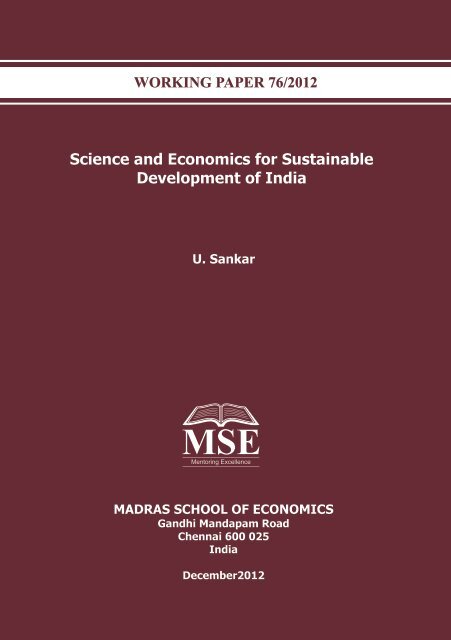
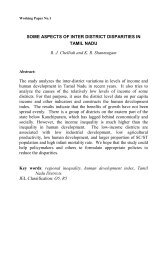
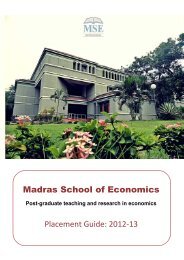
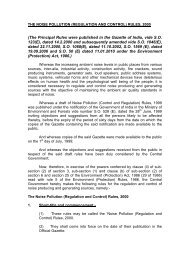
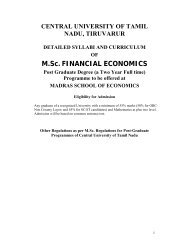
![Curriculum Vitae [pdf] - Madras School of Economics](https://img.yumpu.com/49878970/1/190x245/curriculum-vitae-pdf-madras-school-of-economics.jpg?quality=85)
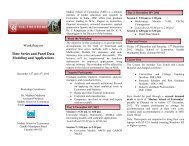
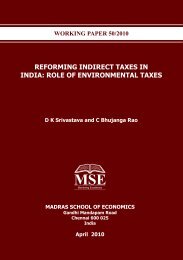
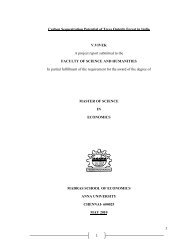
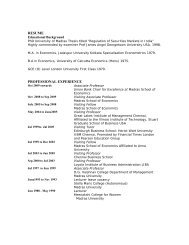
![Curriculum Vitae [pdf] - Madras School of Economics](https://img.yumpu.com/48715201/1/184x260/curriculum-vitae-pdf-madras-school-of-economics.jpg?quality=85)
